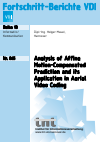Zusammenfassung
Kurzzusammenfassung:
This work deals with affine motion-compensated prediction (MCP) in video coding. Using the rate-distortion theory and the displacement estimation error caused by inaccurate motion parameter estimation, the minimum bit rate for encoding the prediction error is derived. Similarly, a 4-parameter simplified affine model as considered for the upcoming video coding standard VVC is analyzed. Both models provide valuable information about the minimum bit rate for encoding the prediction error as a function of the motion estimation accuracy.
Although the bit rate in MCP can be reduced by using a motion model capable of describing the motion in the scene, the total video bit rate may remain high. Thus, a codec independent coding system is proposed for aerial videos, which exploits the planarity of such sequences. Only new emerging areas and moving objects in each frame are encoded. From these, the decoder reconstructs a mosaic, from which video frames are extracted again. Th...
Schlagworte
video coding affine motion-compensated prediction (MCP) simplified affine motion-compensated prediction rate-distortion theory aerial surveillance region of interest (ROI-) based video coding global motion compensation (GMC) moving object detection long-term mosaicking radial distortion compensation- Kapitel Ausklappen | EinklappenSeiten
- 1–10 1 Introduction 1–10
- 11–36 2 Basics 11–36
- 87–116 5 Experiments 87–116
- 133–152 Bibliography 133–152

